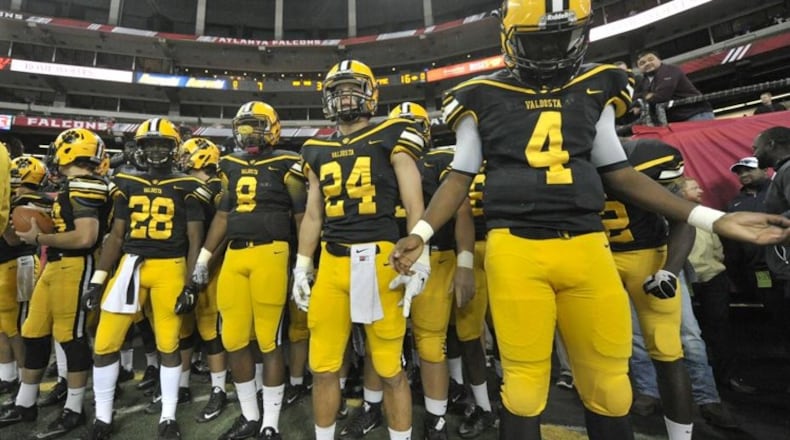Today's interviewee is Sandy Atkins, the foremost historian for Valdosta football, and perhaps for high school football statewide. In the 1980s, Atkins meticulously researched Valdosta's history and established the basis for Valdosta's claim nationally as having the most victories of any football program in history, currently at 924 victories.
Sandy Atkins, Valdosta football historian
1. Valdosta's glory years lasted some 50 years, at least. You grew up in the middle of that vast era. What were those days like as a kid? "Growing up in Valdosta in the '60s and '70s was magical. For a young man, the sporting opportunities were limitless with the Boys Club leagues, church leagues and all of the school-sponsored athletics available. But Valdosta High School Wildcat football was extra special. My father took me to my first Wildcat game in the mid-1960s when I was 7 or 8 years-old. All my friends were there with their fathers, and we soon realized we could be on that field one day playing before 12,000 fans. I still remember Friday nights walking down tree-canopied Williams Street to the stadium to see the Cats. I was in a large gang, but it was a good gang: pre-teen wannabe Wildcats going to root for their heroes. Coach Wright Bazemore and his staff were generous and attentive towards even the youngest of boys. I still recall his regular attendance at the Saturday youth games. He never interfered or sought attention. Instead he would position himself so as to be the least obvious but to get a good viewing of the action. He did this as well with the local black high school games in the area. If it was football, he was there." [Valdosta won seven state titles in the 1960s alone.]
2. Around your high school years, Valdosta went through big changes - desegregation, a new school and a new coach. What were those transitional years like? "The years 1967-77 were very eventful years for VHS. Amazingly, despite almost daily challenges, the system survived and prospered. The school system began voluntary desegregation in the mid-'60s, so when the federal courts ordered such in the '70s Valdosta was ahead of the curve. The greatest challenge was overcrowding that forced dramatic changes of the infrastructure, renovations and expansions, a new high school, the creation of a busing system, etc. Due to overcrowding, the Valdosta High class of 1975 attended three different high schools - Pinevale [ninth-graders], the old VHS next to the stadium [10th-graders] and the woefully incomplete new VHS on Forest Street [11th- and 12th-graders]. Coach Bazemore's Cats provided the glue that kept the city together, and his last teams were some of his best. Some (adult) individuals tried to use the Wildcats for political purposes, but this was thwarted by a unified front from the senior leadership on more than one team. Coach Charlie Greene followed Bazemore, who retired at a very early age. Again, some (adult) individuals schemed to oust Greene, thinking this would compel Bazemore's return. It did not work, and the program took a devastating blow. Fortunately, with Bazemore's guidance, the school found the right man to continue leading the Cats, Nick Hyder from West Rome High." [Pinevale, the Valdosta high school for African-American students, closed in 1969. The success of Valdosta's 1971 team, often considered the state's most dominant in history, is partly due to the smooth transition into desegregation that not all Georgia high schools experienced. Bazemore retired after the 1971 season with 14 state titles. Hyder, who began in 1974, won another seven.]
3. Valdosta was perhaps the first high school in the state to put together an annual media guide that exceeded those of many college programs. It went from a four-page foldover roster to a full-color, glossy 80-page game program that sold at home games. What inspired that? "The aim of this guide was to get the names of Wildcats in front of as many journalists and recruiters as possible. Blue-chip Cats have always attracted attention from the majors, but less well-known players who could easily start at Division II, III, NAIA or JUCO levels were too often missed. We also wanted the guide to ease some of the burden on our coaches who would talk endlessly and honestly to recruiters about Cat prospects. With a digest of facts such as heights, weights, sprint times, etc., recruiters could have some of their homework in hand before calling. Scott Alderman handled the bio information, and I contributed historical and scheduling info. Another old Wildcat, Bill Malone, provided the design, artwork and graphics. Most surprising of all, the media guide also became a big money maker for the Touchdown Club." [Atkins also drove thousands of miles and spent countless hours in libraries around the state, checking out microfilm and researching not just the Wildcats' history but those of other south Georgia teams, making copies and recording his data on paper before the days of computers. His work was the most extensive into the state's football history until the Georgia High School Football Historians Association became well-established.]
4. How do you feel about Valdosta football today? Will it ever return to the glory days of Bazemore and Hyder? "Valdosta football is prospering still in our rapidly evolving political/social/cultural world. This is due to the leadership in the system, from superintendent to bus driver. It is unique in that leadership is found at every point along the way. Everyone working together for the education of future citizens of our community and nation. And the most visible educational process can be witnessed on Friday nights at Bazemore-Hyder Stadium in the fall. Coach Alan Rodemaker and his staff continue to teach excellence on a daily basis, and Valdosta is blessed to have them guiding the young men
Produced by Georgia High School Football Daily, a free e-mail newsletter. To join the mailing list, click here.
About the Author
The Latest
Featured

